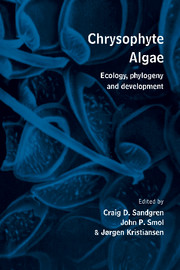Book contents
- Frontmatter
- Contents
- Preface
- List of contributors
- 1 History of chrysophyte research: origin and development of concepts and ideas
- Part I Phylogeny, systematics and evolution
- Part II Development, physiology and nutrition
- Part III Ecology, paleoecology and reproduction
- Part IV Contributed original papers
- 14 Mallomonas variabilis, sp. nov. (Synurophyceae) with stomatocysts found in Lake Konnevesi, Finland
- 15 Scale morphology and growth characteristics of clones of Synura petersenii (Synurophyceae) at different temperatures
- 16 Status of the Chrysamoebales (Chrysophyceae): observations on Chrysamoeba pyrenoidifera, Rhizochromulina marina and Lagynion delicatulum
- 17 The genus Paraphysomonas from Indian rivers, lakes, ponds and tanks
- Index of scientific names
- Subject index
15 - Scale morphology and growth characteristics of clones of Synura petersenii (Synurophyceae) at different temperatures
Published online by Cambridge University Press: 05 March 2012
- Frontmatter
- Contents
- Preface
- List of contributors
- 1 History of chrysophyte research: origin and development of concepts and ideas
- Part I Phylogeny, systematics and evolution
- Part II Development, physiology and nutrition
- Part III Ecology, paleoecology and reproduction
- Part IV Contributed original papers
- 14 Mallomonas variabilis, sp. nov. (Synurophyceae) with stomatocysts found in Lake Konnevesi, Finland
- 15 Scale morphology and growth characteristics of clones of Synura petersenii (Synurophyceae) at different temperatures
- 16 Status of the Chrysamoebales (Chrysophyceae): observations on Chrysamoeba pyrenoidifera, Rhizochromulina marina and Lagynion delicatulum
- 17 The genus Paraphysomonas from Indian rivers, lakes, ponds and tanks
- Index of scientific names
- Subject index
Summary
Introduction
Synura petersenii has a worldwide distribution. It is often an important, and frequently the most common, Synura species of the phytoplankton (Kristiansen 1979; Siver 1987; Hällfors & Hällfors 1988; Hickel & Maass 1989). This taxon appears to be pH and temperature indifferent and often occurs under eutrophic conditions (Kristiansen 1975, 1986, 1988; Kies & Berndt 1984; Roijackers 1986).
The first monograph of the genus Synura by Korshikov (1929) was based on scale morphology. Balonov & Kuzmin (1974) later differentiated the genus into three sections: Synura, Petersenianae and Lapponicae. The section Petersenianae is an exception, as the species are distinguished by differences in the construction of elements of scales, whereas the species of the other sections exhibit explicitly different elements (Fott & Ludvik 1957). Several subspecific taxa within this section have been described on the basis of variations in the scales (Siver 1987, 1988); however, it is often difficult to distinguish them from the type for several reasons. First, there is variability among scales of the armour of the same cell (e.g. between body and caudal scales; Fig. 15.4(1, 2)). Second, some taxa are distinguished even though not all scales of the cell armour are significantly different from the type. Third, continuous transitions among subspecific taxa often occur (Siver 1988).
- Type
- Chapter
- Information
- Chrysophyte AlgaeEcology, Phylogeny and Development, pp. 345 - 360Publisher: Cambridge University PressPrint publication year: 1995
- 10
- Cited by

